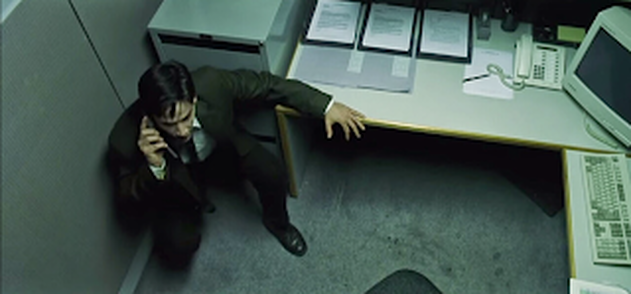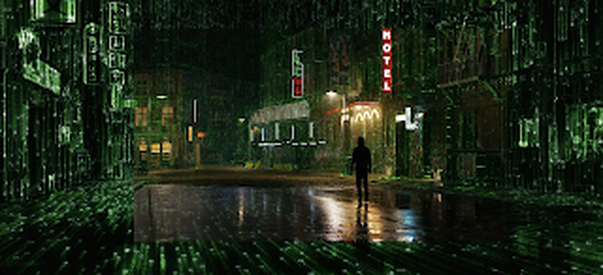|
The Matrix is a film about work. Long before Neo escapes the matrix he has to break out of a much more mundane space of confinement, the office cubicle. The film is thus part of that odd series of films that came out in 1999 that were about the confines of the cubicle and the working day, a list that includes Office Space, Fight Club, and American Beauty (and Being John Malkovich). It was an odd year, in the midst of the dot-com bubble and the Clinton third way, a year that on the surface was good for capitalism, the movies were telling a different story, a story in which work and the office was sucking the life out of people. An idea which The Matrix made literal in its dystopian future of energy sucking pods, in other words, cubicles 2199. In The Matrix we see two different escapes from this world. The first, in the film's opening scenes, is offered by the internet, by the world of hacking. Thomas Anderson/Neo (Keanu Reeves) is cubicle drone by day and hacker by night. Two different lives each with different futures. The first is one of quiet desperation, one that provokes the question about the nature of life and control, or, as the film puts it "What is the Matrix?". The other is one that gets him out of the house and eventually brings him into contact the answer to the question, to understanding what the Matrix is. As it has often been noted the matrix itself can be understood to be a kind of allegory for the internet, or at least early ideas about the internet. On the one hand there is the capacity for self invention and reinvention, exemplified by the collection of various styles and fashions that the "digital selves" wear in the Matrix, three piece suits, trench coats, and gravity defying sunglasses, coupled with the ideal of the dissemination and even democratization of knowledge though digitization. It is a world in which anyone can know anything at the touch of a button, even kung fu. On the other hand, the ubiquity of surveillance and control, agents are everywhere and everything is monitored. The Matrix success was not just in its ability to capture the frustration with the world of the cubicle but it also began to chart out in the imagination the new spaces of escape and control that were being hatched from so many cubicles, on so many computer screens, the space of the virtual world. The internet was in many ways driven by a line of flight, an attempt to escape the cubicle, even if those lines of flight ended with people tethered to laptops, trying to figure out new ways to disrupt industries in order to survive. When The Matrix Resurrections opens, those two identities, the two lives, office worker by day/hacker by night have been merged into one. We meet Thomas Anderson successful video game designer. He has designed three successful Matrix games. He no longer works in a cubicle but in the corner office of a workspace that is as open plan and as "fun" as one would expect. Complete with a coffee shop, Stimulations, that functions as its necessary extension. Computers are no longer the dull grey machines by day, and place of illicit escape by night, but are both at once. Frustration and boredom no longer leads to a search for the true sources of control over society, but towards escape. As one of Thomas' co-workers confessed he nearly ruined middle school by spending all of his time in the Matrix. Escape is not what it once was, nor is control. Much is made about the meta-nature of the fourth film. It begins with Warner Brothers demanding a new sequel to the Matrix. It reminds us that even those films that frame our fantasies of escape, of blowing up the cubicles we work in, are only made if they can make a profit. Many have interpreted these scenes to be Lana Wachowski expressing her own reluctance of being drawn back into her successful franchise. They also function as something of a theory of the blockbuster film itself, or at least an earlier era of the blockbuster. As one character states in the pitch meeting "we need to think bullet time," referencing the first film's special effect that slowed down time so that we could watch characters dodge bullets. The history of the blockbuster, especially the science fiction film, is often one in which images of science fiction futures is made possible by actually existing technological innovations off of the screen. Think Terminator 2 and the liquid metal of the T-1000, Jurassic Park and CGI dinosaurs, and The Matrix and bullet time as a new depiction of action. It used to be a new film needed a new gimmick to become a hit, something to drive people to the spectacle. The contemporary superhero film, or, to be more accurate Intellectual Property film if you include the Star Wars movies, seems to have severed this link. More or less using the same CGI, driving people to the theater to see the next installment not because of spectacular effects but to finally see this or that character return or appear for the first time. Hence the importance of the post-credit scene. This theory of the blockbuster, and its changing role is not an aside, but brings us back to the nature of the film itself, the way it theorizes control and the way in which it enacts it. The Matrix Resurrections is in some sense a sentient blockbuster, aware of the constraints it faces and the possibilities it opens. The line about "bullet time" is one aspect of its self-awareness and limitation. There is no new effect that makes the film a marked departure from the original three, not qualitatively different. Bullet time appears again, but instead of the image slowing to the point where we can see the imperceptible act of dodging bullets it is drawn out to allow for the villain's monolog. To refer to David Graeber's point cited above, there was a point where the only straight line of technological progress was in special effects, we got no closer to exploring the solar system or building robot butlers but the renditions of spaceships and robots on the screen got better with each passing year. Perhaps there is even a slowdown in the rate of special effects. The lack of technical innovation behind the screen is matched by the films halfhearted attempt to deal with the changes of technology in the word since it was first released. There are a few lines about no longer needing landlines as the interface between the matrix and the real world. The matrix of the latest film is simultaneously more spatially defined, appearing as a specific city, San Francisco, rather than the anyplace whatsoever that defined the first film, and disconnected, as it is possible to enter in Paris and open a door onto a bullet train in Japan, but this is indistinguishable from the globe trotting that defines the thriller as a genre. The one point where the film seemed to reflect the change of the modern internet is that the agents of the previous film, the fast and deadly forms of control that could appear anywhere, are replaced by "bots" that can appear anywhere and in large numbers. Swarms of programmed hostility would seem to be just as important to understanding the modern internet of social media as disseminated control was to its earlier version. Both the original film and its latest iteration have what could be called thesis statements about the nature of control. The first is offered by Agent Smith who offers the following as an explanation of the matrix, "Did you know that the first Matrix was designed to be a perfect human world? Where none suffered, where everyone would be happy. It was a disaster. No one would accept the program. Entire crops were lost. Some believed we lacked the programming language to describe your perfect world. But I believe that, as a species, human beings define their reality through suffering and misery." This idea that human beings are controlled not by an ideal by some idealized version of the world, but by both desires and fears, hope and despair is returned to again. As the analyst states in the latest film. "It is all about fiction. The only world that matters is the one in here (pointing to the head), and you people believe the craziest shit. Why? What validates and makes your fictions real? Feelings." To which he adds later, "Feelings are easier to control than facts." This statement could be understood as a thesis statement about the changes that the internet has gone under since the first film, from a conflict over control over knowledge and information, or at the very least intellectual property (Napster and The Matrix came out the same year) to the internet of social media, one driven less by conflicts of control over information than control through anger, hope, and despair. This is interesting as a statement about the internet, but it is hard to see it working out in the film. There are some interesting aspects of emotional control through both the film's critique of therapy and psychiatric drugs as a regime of control, and, more to the point, in the case of Trinity, of the family as a form of emotional control. The film does not really follow through with these, does not really offer us a map of the forces of emotional or affective control that dominate modern life. The reason for this is given in the post-credit scene, which is less about setting up the next sequel than explaining the demise of film itself. Feelings no longer need narrative structure when a cat video or quick meme can do. Apparently, The Matrix Resurrections has not been the same hit of its predecessors. I for one was glad to be able to watch it at home, but a week before it released millions of people returned to the theaters to see the latest Spider-Man movie. To cheer with other people. Perhaps, and this goes beyond the scope of this post, what I have referred to as intellectual property films have to be understood in terms of their own affective economy, their combination of hope and fear, or, more to the point, nostalgia as an emotion. AuthorJason Read is Professor of Philosophy at the University of Southern Maine. He is the author of The Micro-Politics of Capital: Marx and the Prehistory of the Present (SUNY 2003) and The Politics of Transindividuality (Brill 2015/Haymarket 2016) and a forthcoming collection of essays, The Production of Subjectivity: Between Marxism and Post-Structuralism (Brill 2022) as well as The Double Shift: Marx and Spinoza on the Politics and Ideology of Work (Verso 2023). He blogs on popular culture, philosophy, and politics at unemployednegativity.com. This article was originally published in Jason's blog Unemployed Negativity. Archives January 2022
0 Comments
Leave a Reply. |
Details
Archives
July 2024
Categories
All
|



 RSS Feed
RSS Feed